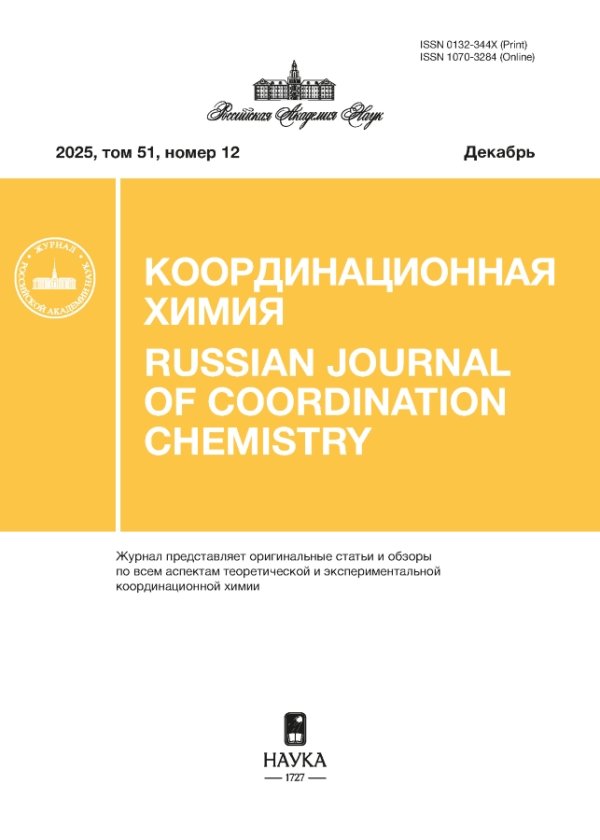Том 49, № 8 (2023)
Статьи
Реакции треугольных кластеров молибдена и вольфрама с тетрабромопирокатехином
Аннотация
Реакция кластерного комплекса (nBu4N)2[Mo3Se7Br6] с тетрабромопирокатехином (H2Тbc) в присутствии Et3N и Ph4PBr приводит к образованию (Ph4P)2[Mo3Se7(Тbc)3] ∙ 2MeOH (Ia ∙ 2MeOH). Его вольфрамовый аналог (nBu4N)2[W3S7Br6] в тех же условиях полностью или частично разрушается с образованием комплекса (Ph4P)(Et3NH)[WO2(Тbc)2] (II). Структуры Iа · 2МеОН и II установлены методом рентгеноструктурного анализа (CCDC № 2213900 и 2213901 соответственно). Окислительно-восстановительные свойства комплекса Ia, а также его аналогов (Ph4P)2[Mo3S7(Тbc)3] (Ib) и (Ph4P)2[Mo3S7(Тcc)3] (Ic) (Тcc = тетрахлорокатехолат) были изучены методом циклической вольтамперометрии.
 451-457
451-457


Перенос спинового порядка с молекулы параводорода на цианидный ион в комплексе иридия в условиях SABRE
Аннотация
На примере нового карбенового комплекса иридия впервые продемонстрирована возможность создания высокой степени спиновой поляризации ядер 13C и 15N в цианид-анионе, образующем координационную связь с ионом металла, под действием параводорода. В ходе анализа спектров ЯМР 13С, зарегистрированных с использованием широкополосной и селективной гетероядерной развязки, определены константы спин-спинового взаимодействия в полученном комплексе и установлено строение гидридного интермедиата. Показано, что цианид-анион координируется к иону металла атомом углерода в одном из двух экваториальных положений, а две молекулы пиридина располагаются в аксиальном и экваториальном положениях. Коэффициент усиления сигналов ядер 13С и 15N цианид-аниона (5665 и –49 555 соответственно) оценен при помощи спектроскопии ЯМР поляризованного вещества методом SABRE из ультраслабого магнитного поля 0.5 мкТл. Данное усиление соответствует 15.5% поляризации ядер азота, достигнутой за несколько секунд при комнатной температуре.
 458-465
458-465


Синтез и строение тетраядерных гетерометаллических карбоксилатов железа(II)-лития, стабилизированных N-донорными лигандами
Аннотация
В результате многокомпонентных химических реакций с участием Fe(SO4) ∙ 7H2O, Li(Рiv), K(Рiv) (Рiv = пивалат-анион) и гетероциклических N-донорных лигандов (пиридин (Рy), 1,10-фенантролин (Рhen)), проведенных в сухом ацетонитриле в инертной атмосфере, синтезированы новые гетерометаллические тетраядерные комплексы [\({\text{Fe}}_{2}^{{{\text{II}}}}\)Li2(Рiv)6(Рy)2] (I) и [\({\text{Fe}}_{2}^{{{\text{II}}}}\)Li2(Рiv)6(Рhen)2] (II), в которых все карбоксилатные анионы выступают в роли мостиковых лигандов. Молекулярная и кристаллическая структура соединений установлена методом РСА (CCDC № 2220576 (I), 2220577 (II · 2CH3CN). В исследованных комплексах атомы железа(II) находятся в искаженном октаэдрическом лигандном окружении.
 466-473
466-473


Комплексы терефталатов Cu(II), Co(II) и Zn(II) с гидроксиалкилами
Аннотация
Впервые изучено взаимодействие терефталатов Cu(II), Co(II) и Zn(II) с гидроксиалкиламинами: трис(2-гидроксиэтил)амином, бис(2-гидроксиэтил)амином, трис(гидроксиметил)аминометаном и бис(2-гидроксиэтил)-амино-трис(гидроксиметил) метаном. Строение и свойства синтезированных комплексов были исследованы методами ИК-, электронной спектроскопии, масс-спектрометрии, элементным и термическим анализом. С помощью монокристального рентгеноструктурного анализа была исследована структура биядерного смешанно-лигандного комплекса [Cu2(TEA)2(Tph)]n · H2O (CCDC № 2224437).
 474-484
474-484


Молекулярные переключатели LD-CISSS-типа на основе бис-хелатных азометиновых комплексов Ni(II). Квантово-химическое моделирование
Аннотация
При помощи (DFT/B3LYP/6-311++G(d,p))-расчетов изучены бис-хелатные азометиновые комплексы Ni(II) с фотоактивными (имидазольными и бензимидазольными производными азосоединений, азометинов и стильбенов) фрагментами, проявляющие свойства молекулярных магнитных переключателей по механизму светоуправляемого координационно-индуцируемого переключения спиновых состояний (LD-CISSS). Определены структурные и энергетические характеристики комплексов, способствующие или ограничивающие возможности рассмотренных комплексов при использовании в качестве молекулярных переключателей.
 485-492
485-492


Физико-химическое исследование комплексов триметилплатины(IV) для MOCVD-приложений
Аннотация
Уточнена структура триметилплатины(IV) иодида [(CH3)3PtI]4 (I) (CCDC № 22330007) и определена структура впервые полученного комплекса триметилплатины(IV) с тридентатным N,N,O-иминокетонатом [(CH3)3Pt(C9H17N2O)] (II) (CCDC № 22330008). Методами элементного анализа и спектроскопии ИК, ЯМР подтверждена чистота выделенных фаз. Термическое поведение комплекса II исследовано методом термогравиметрии. С помощью квантово-химических расчетов оценены энергии ионизации и фрагментации молекул II, приводящие к образованию наиболее устойчивого фрагмента [(CH3)3Pt]+. Комплекс II протестирован в процессах MOCVD. Пленки Pt с выраженной (111)-текстурой с размерами частиц около 100 нм были получены на Si-пластинах в присутствии кислорода.
 493-503
493-503


1,2,4-трифенилциклопентадиенильные комплексы празеодима и эрбия
Аннотация
Взаимодействие трифенилциклопентадиенилкалия с тетрагидрофуранатами хлоридов празеодима и эрбия, в зависимости от соотношения реагентов, приводит к образованию тетраядерных ат-комплексов [{(Ph3C5H2)Pr(THF)}2(µ2-Cl)2(µ3-Cl)3K]2(C7H8)4 (I) и [{(Ph3C5H2)Er(THF)}2(µ2-Cl)2(µ3-Cl)3K(THF)]2 (III); и биядерных ат-комплексов [(Ph3C5H2)2LnCl(KCl)]2 Ln = Pr (II), Er (IV) (CCDC № 2224244 (I), 2224243 (II), 2224245 (III), 2224242 (IV)). В основе сходных по строению комплексов I и III лежит остов {[Ln2(µ-Cl)3]2(µ-Cl)2K2}, в III катион калия дополнительно координирован молекулой ТГФ. В основе строения изоструктурных II и IV биядерный остов [Ln(µ-Cl)2K]2.
 504-512
504-512












